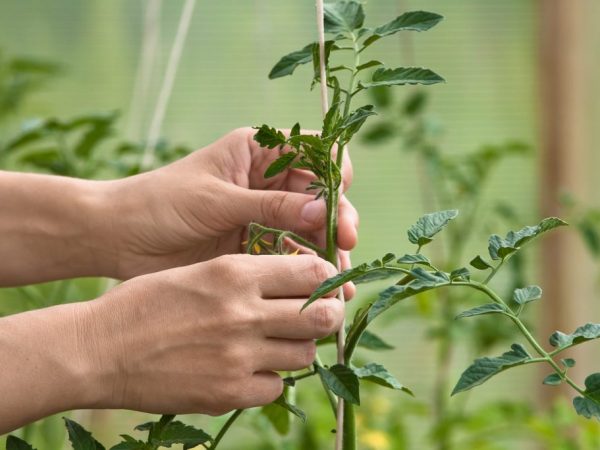Rules for tying tomatoes
Tomatoes in open soil must be tied up so that the stem is kept straight and the bush does not break. Each variety requires a timely garter, but especially those that grow above 2 m.Let's consider how to properly tie up tomatoes.

Rules for tying tomatoes
What is support for?
Tying tomatoes is not a fad. A simple and easy procedure has a great impact on the future harvest. Let's figure out why to tie up tomatoes:
- The main stem does not bend or break as it grows, the tied plant is able to withstand the weight of the fruit, as a result, the bush does not fight for survival, but gives all its strength to the growth of the fruit.
- A vertically growing bush receives the maximum amount of sunlight and fresh air, the root system doubles.
- If the bush is tied up, rain is not a problem.
- Tied tomatoes are easier to spray, and this increases the immunity of the bush.
- Thanks to the garter, it becomes much easier to carry out preventive procedures.
- Tying the tomatoes makes it much easier to care for the seedlings. The main thing is not to violate the technology of fastening tomatoes. If you do something wrong, the fruits will receive a large amount of moisture, and an excess of water for this culture is destructive.
- Fasteners are able to protect fruits growing too close to the ground from insect attack.
- Thanks to the garter, the fruits will not lie on the ground, which will protect them from infection - rot.
They begin to build a structure 1-3 weeks after planting in unprotected land. On average, the plant is strengthened 2-7 times per season, tying new shoots to the main support. The number of supports is adjustable, depending on the variety and its height.
Garter techniques
Let's figure out how to tie tall tomatoes correctly.
There are 3 most popular ways to tie tomatoes:
- stakes;
- trellises;
- cells or crochet.
Twine is used in almost all garter methods as one of the improvised means, the main thing is not to tighten it too much so that it does not press on the main stem. Absolutely any fabric put on strips is suitable for fastening.

Use only soft material for tying
Neither wire, nor fishing line, nor any other hard material is suitable for garter tomatoes, as it will cut into the base of the bush, as a result, infection and death of the plant will occur. For greenhouses, it is best to use natural fabric, for open soil this is not the best choice.
Stakes method
The easiest way to tie up tomatoes is using tall wooden stakes. Sometimes such platforms can be metal, the main thing is that the metal is clean, without dirt.
The height of the stake should correspond to the height of the bushes so that they can withstand the load of the fruit and the bush. For low varieties, support materials are used with a height of no more than 40 cm.For tall bushes, the stakes should be higher than 3 m.
Each support material is reliably fixed in the ground - the stakes are placed in the ground 30 cm deep, but not more.The distance between the bush and the stake should be 12 cm so as not to accidentally damage the root system.
Tomatoes are tied loosely, but first they fix the string on a peg, then they carefully wrap the stem and the string. As the plants develop, the leash must be loosened.
Trellis method
The trellis method is used in a large garden. For its implementation, you will need a small bar or dense pegs.
The racks are installed at the beginning and at the end of the tomato beds, then a wire is pulled between them, to which the shoots are attached. The wire method is great for both greenhouses and open ground.
There are 2 ways to pull the shoots onto the wire.
- The wire is pulled tightly over the highest bar at a level of about 3 m. The string should be of a length that can reach from one support to the other. Over time, tomatoes slowly begin to cover the wire completely.
- The wire is tightened on several bars at once. You can make a braid from tomatoes and their shoots. To do this, each is tied up separately, and then stretch marks are created as they grow.
It doesn't matter how to tie the tomatoes, the main thing is not to overtighten the rope so that it does not harm the main stem. Brushes with too heavy fruits are tied up in the same way.
Cages and hooks
A kind of dome cage is created from the wire, subsequently shoots of a bush begin to grow on it. Wire reinforcement should be fixed at a short distance.
You can also crochet. In this case, a wire is lowered onto each separate bush in the form of a hook, on which shoots grow.
Conclusion
Garter tomatoes is a simple matter, the main thing is not to deviate from the basic scheme, and then everything will work out. To carry out the action, they wait until the first shoots appear, after which they are fixed on a wire. If the shoots do not grow properly, you should intervene and shape the growth process in a different way. The ground is not important here.
Tying up tomatoes is a must to get a decent harvest.


